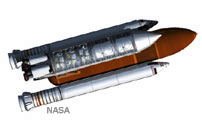NASA Studying Unmanned Solution to Complete Space Station as Return to Flight Costs Grow

NASA is completing an internal review that proposes using an expendable launch vehicle derived from space shuttle components to launch and complete the International Space Station following retirement of the shuttle orbiters in 2010, according to senior agency and industry sources.
The study is to be completed in the next two to three weeks. As a result, the public release of Mike Griffin’s full 60-day exploration architecture study will be delayed until after the House and Senate return from summer recess in early September, sources explained – a delay of almost two months from Griffin’s earlier plans.
Griffin has pledged to legislators a complete proposal to accelerate development of the Crew Exploration Vehicle (CEV), announce the design of its new family of launch vehicles, and the final assembly sequence for the ISS no later than early fall.
The plan is to detail how NASA hopes to alter and, in some cases accelerate the implementation of the Bush administration Vision for Space Exploration (VSE) announced in January 2004. Initial briefings to industry and Congressional representatives several weeks ago fell flat on delivery and left many attendees confused as to what the actual NASA plans are. Griffin was not happy about the initial presentations and has ordered that the whole process be redone. Agency sources note that Griffin’s staff feels that they need several weeks to get things into a form that will be ready for public disclosure.
The delay in completing the exploration plan comes as auditors have warned Griffin and his senior staff that the costs of the shuttle fleet’s Return to Flight are rapidly rising and may exceed $1 billion in unbudgeted costs by the fiscal year 2007 and possibly $2 billion by 2008. Budget analysts have also told senior NASA staffers that they are unable to predict the final price tag for the shuttle repairs and it could exceed even these new, stark projections.
A tacit acknowledgement of the looming dire budget situation came from Chris Shank, an assistant to Griffin, in a speech to the Space Frontier Foundation’s “Return to the Moon Conference” this past weekend. According to sources present at this conference, Shank said that he was specifically cleared by Mike Griffin to say that NASA does not have enough money to implement the exploration architecture it wants to put into place – unless, that is, the private sector lends a hand.
While Griffin’s plans for commercial participation in the VSE – and perhaps alleviation of the cost of implementing the VSE – have been sketchy thus far, he has begun to make preparations to seek more funding from Congress.
To alleviate this budget squeeze Griffin may seek a special, one-time Return to Flight supplemental funding from Congress next year to help the agency absorb the impact — without wrecking plans to advance the VSE. The full implications of the possible cost overruns have not been widely distributed within senior NASA circles, sources say, including the Space Operations Mission Directorate that is responsible for management of the Space Shuttle program. But Griffin’s senior staff are not yet convinced a supplemental will be needed or could be passed next year, a year in which the entire U.S. House of Representatives and one third of the U.S. Senate is up for election in November.
According to agency sources Griffin has said that he is determined not to raid other NASA spending accounts to pay for the shuttle’s ballooning costs. According to one source, Griffin has ordered the RTF costs to be fully absorbed within the space agency’s human spaceflight account. That would leave the ISS science budget and the budget for shuttle operational costs to suffer the full effect of the RTF increases.
Sources say the cost of using a shuttle-derived launch vehicle to complete station assembly post 2010, when the orbiters are retired, could be partially absorbed by the SDV’s development costs being attributed to the Constellation project, since the launcher would be used primarily to lift and assemble parts of the return-to-the-moon fleet in low Earth orbit.
Sources familiar with the SDV review say a side-mounted so-called “Shuttle-C” type configuration is once again being strongly looked at as the configuration for the heavy lift booster. Agency planners have favored a stacked or “in line” configuration that mounts a large liquid fueled upper stage and payload module atop a modified space shuttle external fuel tank. While such a design would yield greater payload weight, sources have said that it would also require the most expensive modifications to the existing space shuttle launch infrastructure. A side-mounted configuration, on the other hand, would replace the winged orbiter with the liquid stage and payload module, using many of the same pad interfaces as now employed with the manned vehicle.
Next: A detailed look inside NASA’s ongoing shuttle-derived launch vehicle trade studies -and a look at how the CEV’s booster choice was made.







